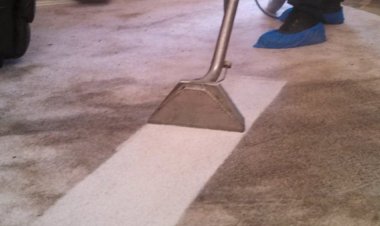Best Ideas to Tackle Impossible Upholstery Stains

Every homeowner's life could be disturbed by tackling difficult upholstery stains. Everybody has experienced the embarrassing stain that a spilled beverage or other accident leaves on their precious upholstery. Everyone puts in their best efforts, but accidents still happen, and our cherished furniture gets stained with unattractive stubborn stains. But don't worry! You can remove even the most difficult upholstery stains with a few basic chemicals and the right techniques. We'll look at some of the greatest Couch Cleaning Gold Coast stain solutions in this blog post to help you in removing those tough upholstery stains.
Tackling Difficult Upholstery Stains: Follow These Steps
Act Quickly: Quick action is essential for tackling difficult upholstery stains. Grab a clean cloth or paper towel as soon as a spill occurs, and gently blot the stain. Blotting aids in absorbing extra liquid and keeps it from permeating the cloth further. Rub gently rather than firmly, which could spread the stain or drive it further into the fibres. Avoid rubbing as this may cause the stain to penetrate the fabric more deeply. By blotting, you can remove the extra liquid and keep it from setting.
Understand Your Upholstery: It's essential to determine the fabric type of your upholstery before using any stain removal techniques. Different fabrics may respond differently to different cleaning solutions and have varying cleaning requirements. While some materials could be more delicate and need effective stain removal, others could be enough to handle DIY stain removal techniques. To find out the best procedure for your particular upholstery fabric, check the care label or refer to the manufacturer's instructions.
Don't Rub, Blot It: When dealing with recent stains, gently dab the affected area with a clean cloth or paper towel. Rub the stain gently; otherwise, it may spread and penetrate the fabric more deeply. Keep in mind to blot rather than rub any spots on furniture. Harsh rubbing could spread the stain or allow it to eat deeper into the cloth, making removal even more difficult. Working from the outer edge towards the centre, gently wipe the stain with a clean cloth or sponge. With no additional harm, this technique assists in removing discolouration.
Test in an Other Place: Always test the cleaning solution on a hidden portion of the upholstery before applying it to the stain. Check for any negative responses by applying a little amount of the cleaning chemical to a hidden area of the cloth, such as the back or bottom. This step is essential to make sure the cloth is not harmed or discoloured by the solution. Treat the stain if the test area reveals no negative effects.
Try Homemade Cleaning Solutions: To get upholstery stains out, you don't necessarily need pricey commercial treatments. Many common products can remove stains effectively. Here are a few efficient home remedies:
- Use mild detergents: To remove water-based stains, use a little warm water with moderate liquid dish soap or laundry detergent. Combine s teaspoon of dishwashing liquid and warm water to treat water-based stains. Apply only a little and gently blot the stain. Using a clean cloth or sponge, apply the solution to the stain, and then gently blot the area. Use water to rinse, then blot dry.
- Use vinegar and water as a cleaning solution: Vinegar works well for tackling difficult upholstery stains. In a spray bottle, combine white vinegar and water in equal parts. Create a solution of equal parts water and white vinegar for stubborn stains. After applying it to the stain, wait a short while before blotting it with a clean towel. Spray the remedy on the stain, allow it to sit for a short while, and then blot it with a fresh cloth. Use water to rinse, then blot dry.
- Baking soda for odours: If a spill has left an odour on the upholstery, sprinkle baking soda over the area and leave it for several hours or overnight. To get the smell out of the baking soda, vacuum it up. Sprinkle baking soda or cornflour on oil-based stains to absorb the oil. After letting it stand for a while, vacuum the powder. If necessary, repeat.
Try Steam Cleaning: Steam cleaning upholstery can work wonders for deep cleaning and effective stain removal. Steam washing equipment goes into the fabric with hot water and steam, lifting dirt and stains. Make sure the cloth is suitable for steam washing and follow the manufacturer's recommendations for proper use.
Protection and routine maintenance: Always choose prevention over cure. Vacuum your upholstery frequently to get rid of dust, dirt, and upholstery stains before they set in deeply. Think about protecting your upholstery with fabric protectors or stain repellents, which can add an extra layer of protection against spills and stains.
Consider Professional Cleaning Service: It is preferable to use expert upholstery cleaning services if the stain is very difficult to remove or delicate, or if you are unclear about how to start. Professional cleaners possess the skills, specialised equipment, and understanding necessary to remove a variety of stains from upholstery safely and effectively. The best course of action is to use expert upholstery cleaning services if everything else fails or if you have to deal with a delicate or priceless piece of furniture. Professional cleaners can remove all kinds of stains while preserving the longevity of your upholstery since they have the knowledge and specialised tools required.
Conclusion:
Even though upholstery stains may appear impossible to remove, with the appropriate strategy, they may be. You'll have a far better chance of getting rid of those seemingly impossible stains if you take quick action, use the right cleaning products, and use the right procedures. Never forget to try any cleaning technique in a hidden location and, if necessary, seek professional help. Your upholstery will remain fresh, clean, and stain-free for years to come if you use these tips.

















